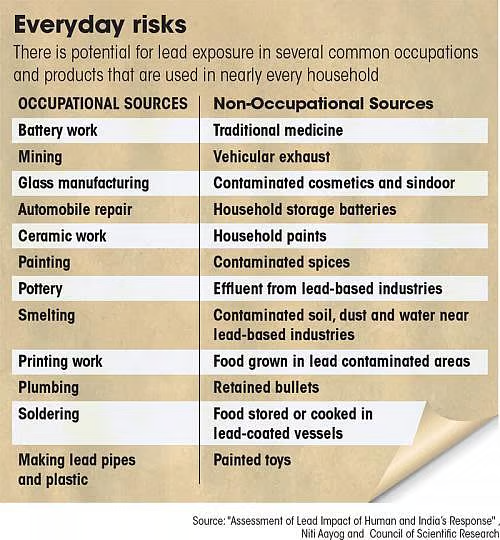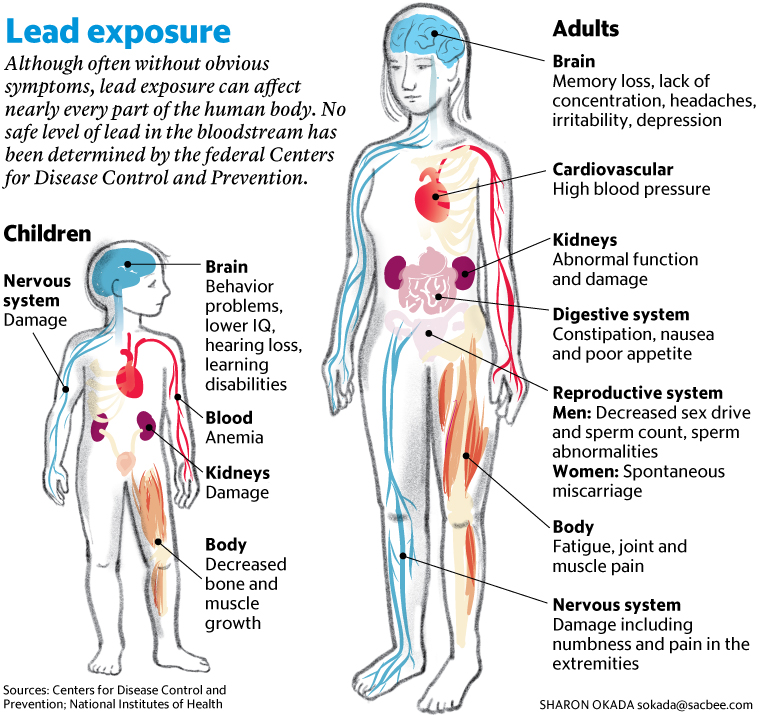What is Lead Poisoning?
Introduction
In India, lead poisoning is still a serious but often disregarded public health issue that mostly affects children. Although lead pollution is regulated by a number of regulations in various industries, effective enforcement and policy consistency are hampered by the lack of a comprehensive legal framework for its prevention and mitigation.
What is Lead Poisoning?
Lead poisoning happens when the body accumulates lead over months or years. Serious health consequences may result from it, particularly for kids younger than six. Although lead occurs naturally, lead poisoning can result from excessive amounts of lead exposure, which is frequently caused by contaminated paint, water, dust, or soil. Symptoms may include headaches, constipation, gastrointestinal discomfort, and in extreme situations, seizures or coma. Finding and minimizing exposure to lead sources is essential to avoiding poisoning.
What are Status of Lead Poisoning?
The status of lead poisoning can be categorized based on severity, public health concerns, and global efforts to mitigate exposure.
- Clinical Status (Severity in Individuals)
- Low Exposure (5-9 µg/dL) – No immediate symptoms but may impact cognitive development in children.
- Moderate Exposure (10-44 µg/dL) – Symptoms may include headaches, abdominal pain, and irritability.
- High Exposure (45-69 µg/dL) – More severe symptoms such as anemia, kidney damage, and difficulty concentrating.
- Severe Exposure (≥70 µg/dL) – Can cause seizures, coma, and death. This is a medical emergency.
- Public Health Status
- Global Concern: Lead poisoning is a major issue, particularly in low-income countries where lead exposure from contaminated water, food, and industrial pollution is common.
- Banning of Lead in Products: Many countries have restricted or banned lead in gasoline, paints, and consumer products, reducing exposure risks.
- Ongoing Challenges
- Older homes still contain lead-based paint.
- Lead contamination persists in water due to old pipelines.
- Some industries still expose workers to lead.
- Epidemiological Status
- According to the World Health Organization (WHO) and Centers for Disease Control and Prevention (CDC), millions of people, especially children, are still at risk.
- The CDC recommends public health interventions when BLLs exceed 3.5 µg/dL.
What are the sources of Lead Poisoning?
Lead poisoning occurs when lead enters the body through various environmental and industrial sources.
- Household Sources
- Lead-based Paint – Peeling, chipping, or dust from old paint can be inhaled or ingested.
- Lead-contaminated Dust – Found in homes with deteriorating lead-based paint or renovations.
- Lead Pipes & Plumbing Fixtures – Can contaminate drinking water, especially in older buildings.
- Environmental Sources
- Soil Contamination – Lead from gasoline (phased out in many countries) and industrial pollution can remain in soil for decades.
- Air Pollution – Emissions from industries, burning leaded materials, and vehicle exhaust in some countries.
- Occupational & Industrial Sources
- Battery Manufacturing & Recycling – Workers handling lead-acid batteries may be exposed.
- Mining & Smelting Operations – Extracting and refining lead releases it into the air and soil.
- Construction & Renovation – Workers in demolition, painting, and plumbing may come into contact with lead.
- Electronics & Soldering – Some industries use lead in circuit boards and metalwork.
- Consumer Products
- Imported Toys & Jewelry – Some low-quality items, especially from unregulated markets, may contain lead.
- Ceramic Dishes & Glazes – Some traditional pottery and cookware may have lead-based glaze that leaches into food.
- Cosmetics & Traditional Medicines – Some beauty products (like kohl) and herbal medicines may contain lead.
- Food & Water Contamination
- Lead in Drinking Water – Occurs when pipes, faucets, or soldering materials contain lead.
- Contaminated Food – Some food products, spices, or canned goods from certain regions may have traces of lead.
What is the Symptoms of Lead Poisoning?
Lead poisoning can affect people differently depending on their age, level of exposure, and duration of exposure.
- Symptoms in Children – Children are more vulnerable to lead poisoning because their developing bodies absorb lead more easily.
- Cognitive Issues: Learning difficulties, lower IQ, trouble concentrating
- Behavioral Problems: Irritability, hyperactivity, aggression
- Developmental Delays: Speech and growth delays
- Physical Symptoms:
- Fatigue and weakness
- Loss of appetite and weight loss
- Stomach pain, constipation, or vomiting
- Headaches
- Pale or anemic appearance
- Seizures (in severe cases)
- Symptoms in Adults
- Neurological Effects: Memory loss, difficulty concentrating, depression
- Physical Effects:
- High blood pressure
- Joint and muscle pain
- Headaches
- Abdominal pain, nausea, constipation
- Reproductive Issues:
- Reduced sperm count and fertility problems in men
- Miscarriages and premature birth in women
- Symptoms in Pregnant Women
- Increased Risk of Miscarriage
- Premature Birth or Low Birth Weight
- Lead Transfer to Baby
- Severe Lead Poisoning Symptoms
- Seizures and Convulsions
- Coma or Loss of Consciousness
- Encephalopathy (Brain Swelling)
- Kidney Damage
What is the Effects of Lead Poisoning?
- Effects on the Nervous System & Brain
- In Children
- Reduced IQ and learning disabilities
- Delayed brain development
- Hyperactivity, behavioral issues, and attention deficits
- Poor memory and problem-solving skills
- Increased risk of aggression and mood disorders
- In Adults
- Memory loss and difficulty concentrating
- Increased risk of depression and anxiety
- Neuropathy (tingling or numbness in hands and feet)
- Seizures and, in severe cases, coma
- In Children
- Effects on the Cardiovascular System
- Increased blood pressure (hypertension)
- Higher risk of heart disease and stroke
- Hardening of the arteries (atherosclerosis)
- Effects on the Blood & Kidneys
- Anemia (low red blood cell count)
- Kidney damage, leading to kidney failure in severe cases
- Increased risk of chronic kidney disease
- Effects on Reproductive System
- In Men
- Lower sperm count and motility
- Erectile dysfunction
- In Women
- Irregular menstrual cycles
- Higher risk of miscarriage, premature birth, or stillbirth
- Lead can cross the placenta and affect fetal development
- In Men
- Effects on Digestive System
- Stomach pain, cramps, and nausea
- Constipation and digestive issues
- Loss of appetite and weight loss
- Effects on Bones & Teeth
- Lead accumulates in bones and teeth, staying in the body for years.
- Weakens bones and increases the risk of osteoporosis.
- Lead in bones can be released into the blood during pregnancy, affecting the baby.
- Effects on the Immune System
- Weakened immune response
- Higher susceptibility to infections
What are India’s policy measures to prevent Lead Poisoning?
India has implemented several policy measures to prevent lead poisoning, focusing on regulation, surveillance, public awareness, and collaboration with international organizations.
- Regulatory Actions
- Phasing Out Leaded Petrol: In April 2000, India successfully eliminated lead from petrol, significantly reducing a major source of environmental lead exposure.
- Regulation of Lead in Paints: The Bureau of Indian Standards (BIS) has established specifications limiting lead content in household and decorative paints. Manufacturers are required to adhere to these standards to minimize lead exposure from painted surfaces.
- Control of Lead in Consumer Products: Regulations have been implemented to limit lead content in toys, cosmetics, and traditional medicines. For instance, certain Ayurvedic preparations are monitored for heavy metal content to ensure safety.
- Water Quality Standards: The BIS has set permissible limits for lead in drinking water. Plumbing materials and fittings are required to meet these standards to prevent lead leaching into water supplies.
- Surveillance and Monitoring
- Blood Lead Level (BLL) Surveillance: Collaborations with organizations like Vital Strategies have led to the design and implementation of BLL surveillance systems in states such as Bihar, Tamil Nadu, and Maharashtra. These efforts aim to identify high-risk populations and inform policy actions.
- Environmental Monitoring: The Central Pollution Control Board (CPCB) conducts assessments of lead contamination in air, water, and soil, particularly in areas near industrial activities like battery manufacturing and smelting.
- Public Awareness and Education
- National Referral Centre for Lead Poisoning in India (NRCLPI): Established following the 1999 International Conference on Lead Poisoning, the NRCLPI focuses on raising public awareness, providing education, and facilitating community involvement to combat lead exposure.
- Community Engagement: Organizations such as Pure Earth India work to educate communities about lead risks, particularly from sources like contaminated cookware, paints, and spices.
- International Collaboration
- Partnerships with NGOs: India collaborates with international non-governmental organizations like Pure Earth and Vital Strategies to implement programs aimed at reducing lead exposure. These partnerships focus on areas such as blood lead surveillance, contamination assessment, and policy advocacy.
- Policy Development Support: Engagements with global entities provide technical assistance in formulating and updating guidelines on clinical management of lead exposure and environmental standards.
Conclusion
Effective lead poisoning prevention requires a thorough regulatory framework, increased enforcement, and public awareness campaigns. Lead poisoning should be India’s top public health priority due to the serious health hazards it poses.
Frequently Asked Questions (FAQs)
Can lead poisoning be cured completely?
Treatment can lower lead levels, but some damage, especially to the nervous system, may be permanent.
How long does lead stay in the body?
Lead can remain in bones for decades, gradually releasing into the bloodstream.
What are the most common signs of lead poisoning in children?
Learning difficulties, irritability, and developmental delays.
Are there safe levels of lead exposure?
No level of lead exposure is considered completely safe.
Sources:
- https://www.who.int/news-room/fact-sheets/detail/lead-poisoning-and-health
- https://en.wikipedia.org/wiki/Lead_poisoning
- https://pmc.ncbi.nlm.nih.gov/articles/PMC4961898/
- https://www.nejm.org/doi/full/10.1056/NEJMra2402527
- https://www.cdph.ca.gov/Programs/CCDPHP/DEODC/CLPPB/Pages/Lead-Poisoning.aspx


Leave a Reply